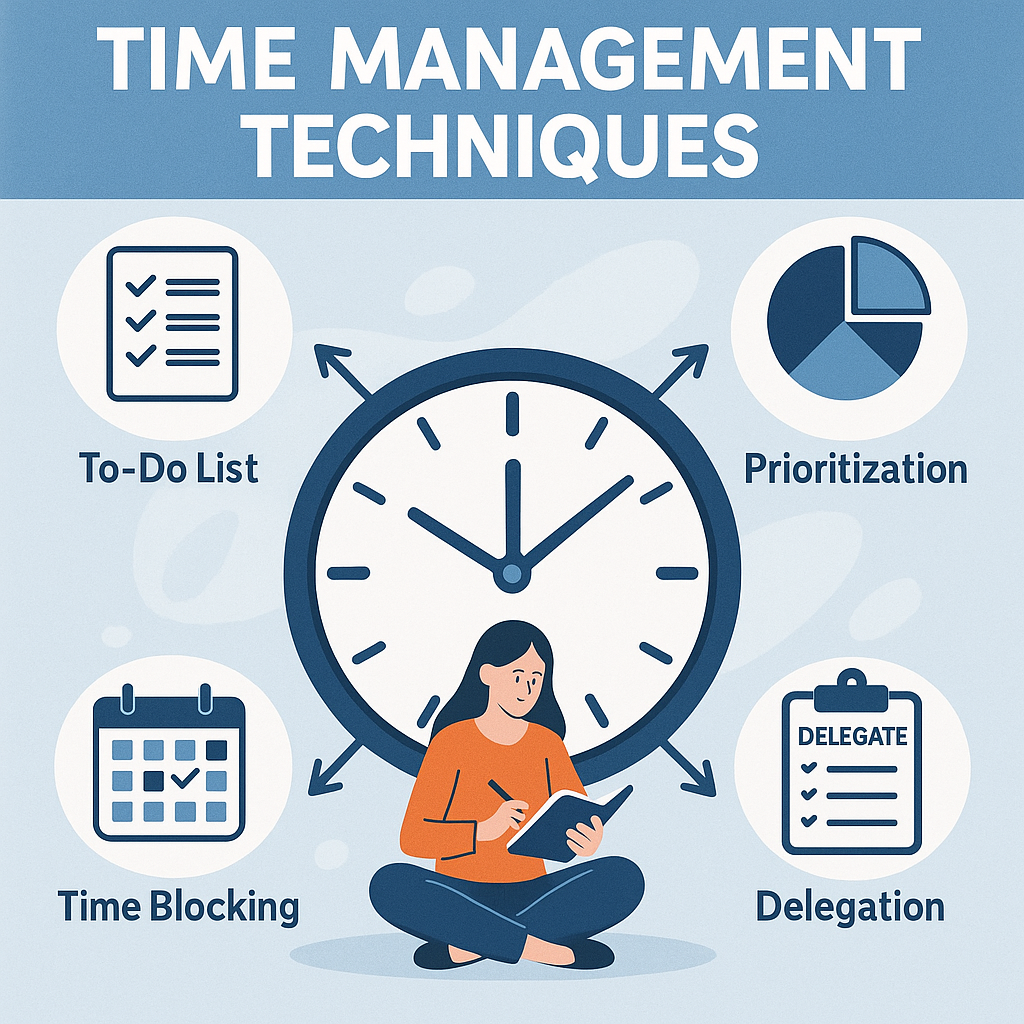In a world filled with distractions and endless to-do lists, mastering the art of time management is essential for anyone looking to boost their productivity. Imagine effortlessly navigating through your day, achieving your goals with precision, and finally feeling in control of your time. The good news is that you don’t need to reinvent the wheel to make this happen. In this article, we’ll explore 10 proven time management techniques that can transform how you work and live. From the simple yet powerful Pomodoro Technique to effective prioritization strategies, these methods will equip you with the skills to maximize your efficiency. Whether you’re a busy professional, a student juggling multiple responsibilities, or someone seeking to regain focus, the tools outlined here will help you craft a day that works for you. Join us on the journey to mastering your day and unleashing your full productivity potential!
Understanding Time Management
Time management is the process of planning and exercising conscious control over the amount of time spent on specific activities to increase effectiveness, efficiency, and productivity. The essence of time management lies in the ability to prioritize tasks, allocate appropriate time to each, and avoid distractions that can derail your progress. Efficient time management helps you accomplish more in less time, leaving you with more opportunities to focus on activities you genuinely enjoy or to simply rest and recharge.
At its core, time management is about making intentional choices. It’s about recognizing that time is a finite resource and that every moment counts. By structuring your day thoughtfully, you can ensure that you are not just busy, but productive. This means focusing on tasks that bring real value and align with your goals, rather than getting bogged down by trivial activities that consume time but offer little reward.
Moreover, mastering time management cultivates a sense of control and reduces stress. When you have a clear plan and know what needs to be done and when, you are less likely to feel overwhelmed. This clarity can significantly enhance your mental well-being, allowing you to approach your work with a calm and focused mindset. In the following sections, we will delve into ten proven techniques that will help you manage your time more effectively and boost your productivity.
###
The Importance of Time Management for Productivity
The significance of time management in boosting productivity cannot be overstated. In an age where distractions are plentiful and demands on our time are high, effective time management is the key to maintaining focus and achieving our goals. Proper time management allows us to allocate our time to high-priority tasks, ensuring that important deadlines are met and projects are completed with the highest quality.
When we manage our time well, we create a structured approach to our daily activities. This structure minimizes the time wasted on indecision and helps us to move seamlessly from one task to another. By doing so, we are able to maintain a steady workflow and avoid the constant start-stop pattern that can hinder our productivity. This continuous progress not only helps in completing tasks more efficiently but also enhances our overall sense of accomplishment.
Furthermore, good time management practices can significantly reduce stress and prevent burnout. When we plan our time effectively, we can balance our workload better and ensure that we have enough time for relaxation and personal activities. This balance is crucial for maintaining our mental and physical health, which in turn impacts our productivity. By taking control of our time, we can work smarter, not harder, and achieve a higher level of productivity without compromising our well-being.
###
Technique 1: The Pomodoro Technique
The Pomodoro Technique is a time management method developed by Francesco Cirillo in the late 1980s. The technique uses a timer to break down work into intervals, traditionally 25 minutes in length, separated by short breaks. These intervals are known as “pomodoros,” the Italian word for tomatoes, named after the tomato-shaped kitchen timer that Cirillo used as a university student.
The Pomodoro Technique aims to reduce the impact of internal and external interruptions on focus and flow. By committing to work for 25 minutes followed by a five-minute break, you can maintain high levels of concentration and prevent burnout. After completing four pomodoros, it is recommended to take a longer break of 15 to 30 minutes to rest and recharge. This cyclical system helps in maintaining sustained attention and productivity throughout the day.
Implementing the Pomodoro Technique can also help in better estimating the time required for tasks. By tracking the number of pomodoros needed to complete a task, you can improve your ability to plan and allocate time for future activities. This increased awareness of how long tasks actually take can lead to more realistic scheduling and a greater sense of accomplishment as you see steady progress.
###
Technique 2: Time Blocking
Time blocking is a simple yet powerful time management technique where you divide your day into blocks of time, each dedicated to a specific task or a group of similar tasks. This method helps in organizing your day into manageable segments, ensuring that every important activity receives the attention it deserves. By assigning specific time slots to tasks, you can minimize the tendency to multitask and stay focused on one thing at a time.
To start with time blocking, begin by identifying your most critical tasks and dedicating the necessary time blocks to them. This could include work-related projects, meetings, personal commitments, or even downtime for relaxation and hobbies. Once you have a clear picture of what needs to be done, allocate specific time slots to each activity, ensuring that there is a balance between work and leisure.
One of the main benefits of time blocking is that it helps in creating a visual representation of your day, making it easier to stick to your schedule. It also reduces the chances of procrastination, as having a specific time assigned to a task creates a sense of urgency and commitment. Additionally, by grouping similar tasks together, you can minimize the cognitive load of switching between different types of activities, leading to increased efficiency and productivity.
###
Technique 3: The Eisenhower Matrix
The Eisenhower Matrix, also known as the Urgent-Important Matrix, is a time management tool that helps you prioritize tasks based on their urgency and importance. Named after President Dwight D. Eisenhower, who famously used this method to make decisions during his presidency, the matrix is divided into four quadrants that help you categorize tasks and allocate your time effectively.
The four quadrants of the Eisenhower Matrix are:
- Urgent and Important (tasks that require immediate attention and have significant consequences if not completed),
- Important but Not Urgent (tasks that contribute to long-term goals and should be scheduled for later),
- Urgent but Not Important (tasks that need to be done quickly but do not significantly impact your long-term goals), and
- Neither Urgent nor Important (tasks that can be eliminated or delegated).
Using the Eisenhower Matrix helps in making informed decisions about which tasks to tackle first and which ones to delegate or eliminate. By focusing on tasks in the “Important but Not Urgent” quadrant, you can work on long-term goals and prevent them from becoming urgent crises. This proactive approach not only increases productivity but also reduces stress by ensuring that you are working on tasks that truly matter and align with your goals.
###
Technique 4: The 2-Minute Rule
The 2-Minute Rule, popularized by productivity consultant David Allen in his book “Getting Things Done,” is a simple yet effective time management technique. The rule states that if a task can be completed in two minutes or less, you should do it immediately rather than postponing it. This approach helps in quickly dealing with small tasks that can otherwise accumulate and become overwhelming.
Implementing the 2-Minute Rule can significantly reduce the clutter in your to-do list and free up mental space for more important tasks. By addressing minor tasks as they arise, you can prevent them from becoming distractions later on. This practice also instills a sense of accomplishment and momentum, as you can quickly check off multiple items from your list, boosting your motivation to tackle larger tasks.
Moreover, the 2-Minute Rule can be a valuable tool for overcoming procrastination. Often, the effort required to remember and organize short tasks can be more significant than the time needed to complete them. By adopting the habit of handling quick tasks immediately, you can streamline your workflow, maintain a cleaner workspace, and keep your focus on more substantial activities.
###
Technique 5: Setting SMART Goals
SMART goals are a well-established method for setting clear, achievable objectives that can enhance productivity and time management. The acronym SMART stands for Specific, Measurable, Achievable, Relevant, and Time-bound. This framework ensures that your goals are well-defined and structured, making it easier to track progress and stay motivated.
Specific goals are clear and unambiguous, answering the questions of who, what, where, when, and why. Measurable goals include criteria for tracking progress and determining when the goal has been achieved. Achievable goals are realistic and attainable, considering your current resources and constraints. Relevant goals align with your broader objectives and priorities, ensuring that your efforts contribute to your overall success. Time-bound goals have a clear deadline, creating a sense of urgency and commitment.
By setting SMART goals, you can create a roadmap for your tasks and projects, making it easier to allocate your time and resources effectively. This structured approach not only enhances productivity but also provides a clear sense of direction, helping you stay focused and motivated. Regularly reviewing and adjusting your SMART goals can ensure that you remain on track and continue to make meaningful progress toward your objectives.
###
Technique 6: Prioritizing Tasks with the ABCDE Method
The ABCDE Method, developed by productivity expert Brian Tracy, is a powerful time management technique for prioritizing tasks. This method involves categorizing tasks into five levels of priority: A, B, C, D, and E. Each category represents a different level of importance and urgency, helping you focus on tasks that have the most significant impact on your goals.
Tasks in Category A are the most critical and have serious consequences if not completed. These tasks should be addressed first and given the highest priority. Category B tasks are important but not as urgent as Category A tasks. While they have consequences, they are not as severe. Category C tasks are those that are nice to do but have no significant consequences if not completed. These tasks can be addressed after A and B tasks.
Category D tasks are those that can be delegated to others, freeing up your time for more important activities. Finally, Category E tasks are those that can be eliminated altogether, as they do not contribute to your goals and can be considered distractions. By systematically categorizing and addressing tasks using the ABCDE Method, you can ensure that your time and energy are focused on activities that bring the most value, enhancing your productivity and effectiveness.
###
Technique 7: Using Technology for Time Management
In today’s digital age, technology offers a wealth of tools and applications designed to enhance time management and productivity. From calendar apps to project management software, these tools can help you organize your tasks, set reminders, track progress, and collaborate with others more efficiently. Leveraging technology can streamline your workflow and ensure that you stay on top of your responsibilities.
Calendar apps, such as Google Calendar or Outlook, allow you to schedule and manage your appointments, meetings, and deadlines in one place. These apps often come with features like reminders and notifications, ensuring that you never miss an important event. Project management tools, like Trello or Asana, help you organize tasks, assign responsibilities, and track progress on team projects, facilitating better communication and collaboration.
Additionally, there are various productivity apps available that can help you stay focused and avoid distractions. Apps like Forest or Focus@Will use gamification or background music to enhance concentration during work sessions. Time tracking apps, like Toggl or RescueTime, can provide insights into how you spend your time, helping you identify areas for improvement and optimize your daily routine. By integrating these technological tools into your time management strategy, you can enhance efficiency and productivity in both personal and professional spheres.
###
Conclusion: Implementing Time Management Techniques for Lasting Change
Mastering time management is not just about implementing a few techniques; it’s about making lasting changes to how you approach your daily activities. The techniques discussed in this article, from the Pomodoro Technique to using technology for time management, provide a comprehensive toolkit for enhancing productivity. However, the key to success lies in consistently applying these methods and adapting them to suit your unique needs and circumstances.
Begin by experimenting with different techniques to identify which ones work best for you. Track your progress and make adjustments as needed to optimize your approach. Remember that effective time management requires discipline and commitment, but the rewards are well worth the effort. By taking control of your time, you can achieve your goals more efficiently, reduce stress, and enjoy a better work-life balance.
In conclusion, the journey to mastering your day and boosting productivity starts with a commitment to improving your time management skills. By adopting the techniques outlined in this article and making them a part of your daily routine, you can transform how you work and live. Embrace the power of time management, and unlock your full productivity potential.




